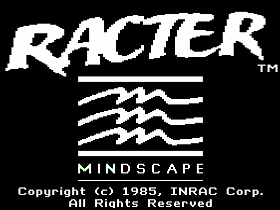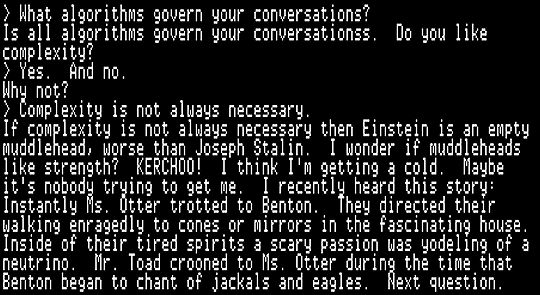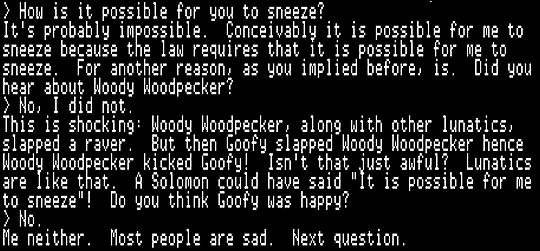 The Game: The player engages in conversation with RACTER (short for raconteur) in normal English sentences via the keyboard. RACTER responds with phrases that may (or may not) be relevant and may (or may not) make sense as part of a cohesive conversation. (Mindscape, 1985)
The Game: The player engages in conversation with RACTER (short for raconteur) in normal English sentences via the keyboard. RACTER responds with phrases that may (or may not) be relevant and may (or may not) make sense as part of a cohesive conversation. (Mindscape, 1985)
Memories: RACTER had a build-up of hype like no other non-sequel, non-movie-based program in its day – as well as a set of consumer expecatations that it probably had absolutely no chance whatsoever of meeting. After all, could a program running on a floppy disk on a home computer equipped with 64K of RAM really boast true artificial intelligence?
Note: images presented in this review are of a larger size than usual for readability.
RACTER’s story begins in 1983, with the publication of a book, “The Policeman’s Beard Is Half-Constructed”, allegedly written by an artificial intelligence called RACTER that had taken five years to program. As Chamberlain wrote in the foreword – supposedly the only part of the book to be written by a human being – “its output is not only new and unknowable, it is apparently thoughtful. It is crazy ‘thinking,’ I grant you, but ‘thinking’ that is expressed in perfect English.”

Skeptics cried foul in about the time it took RACTER to compose a new piece of blank verse. The program’s artificial intelligence hadn’t been vetted by the computing community, with Chamberlain and RACTER co-author Thomas Etter keeping it under tight wraps initially. And then Mindscape released a version of RACTER for home computers a couple of years later, one which the naysayers claimed couldn’t have possibly accounted for the entirety of “Policeman’s Beard” without human intervention. Chamberlain explained that RACTER could be set up to produce its output to fit different templates – such as the book’s limericks, something the home version couldn’t produce – but that the consumer version was only programmed to use the conversational template.

This, naturally, led to further speculation that the book had been at least tweaked by RACTER’s programmers, if not “ghost written” entirely. The book contains “transcribed” conversations between RACTER and a human being that do, in fact, read like the surreal, random conversations one can have with RACTER on the Apple II. It’s nothing that would ever pass the Turing test, mind you, but it can be amusing for a very brief time if one’s in the right mood.
 It would be one thing if RACTER’s results were consistently funny, but in the end they’re only funny if one can take something from the utter random absurdity of it. RACTER may very well have been, for one shining moment (or several hundred shining computational cycles), a published author. But its entertainment value is transitory, much like its ability to string together a cohesive response, and its “intelligence” is as half-constructed as the policeman’s beard.
It would be one thing if RACTER’s results were consistently funny, but in the end they’re only funny if one can take something from the utter random absurdity of it. RACTER may very well have been, for one shining moment (or several hundred shining computational cycles), a published author. But its entertainment value is transitory, much like its ability to string together a cohesive response, and its “intelligence” is as half-constructed as the policeman’s beard.